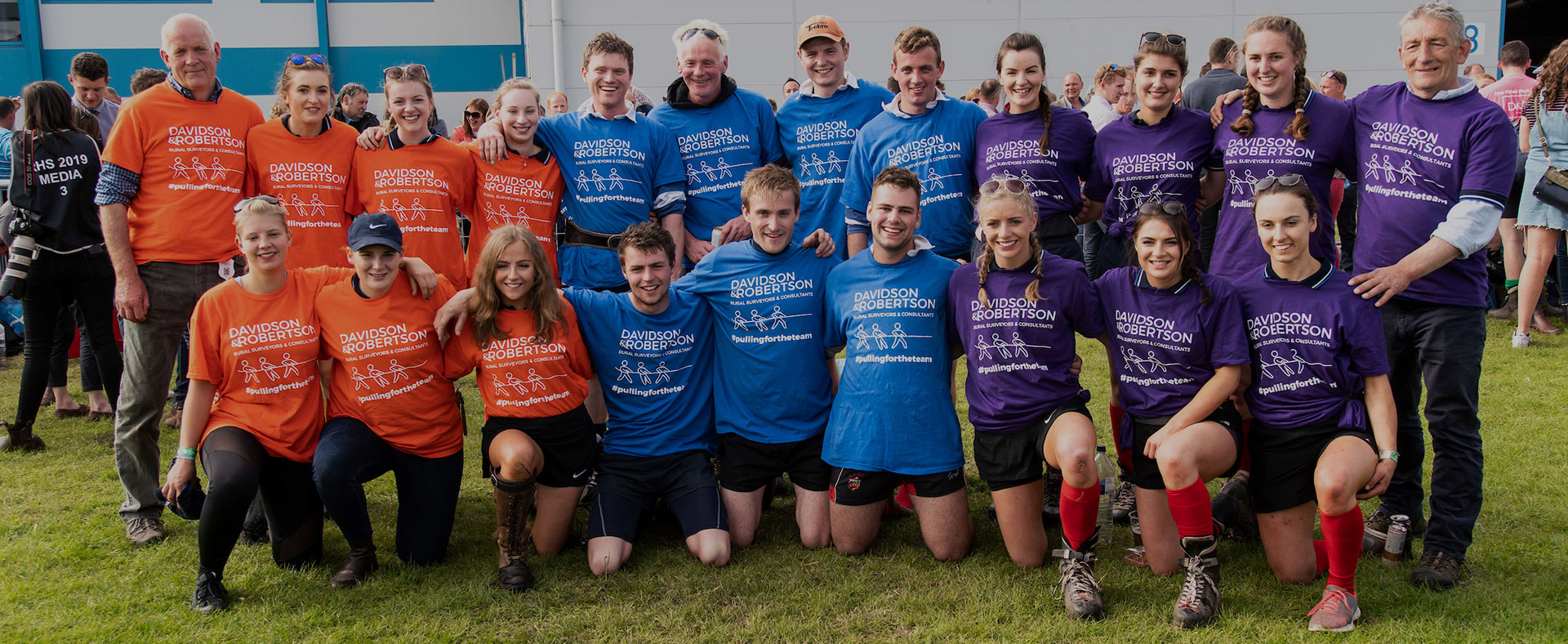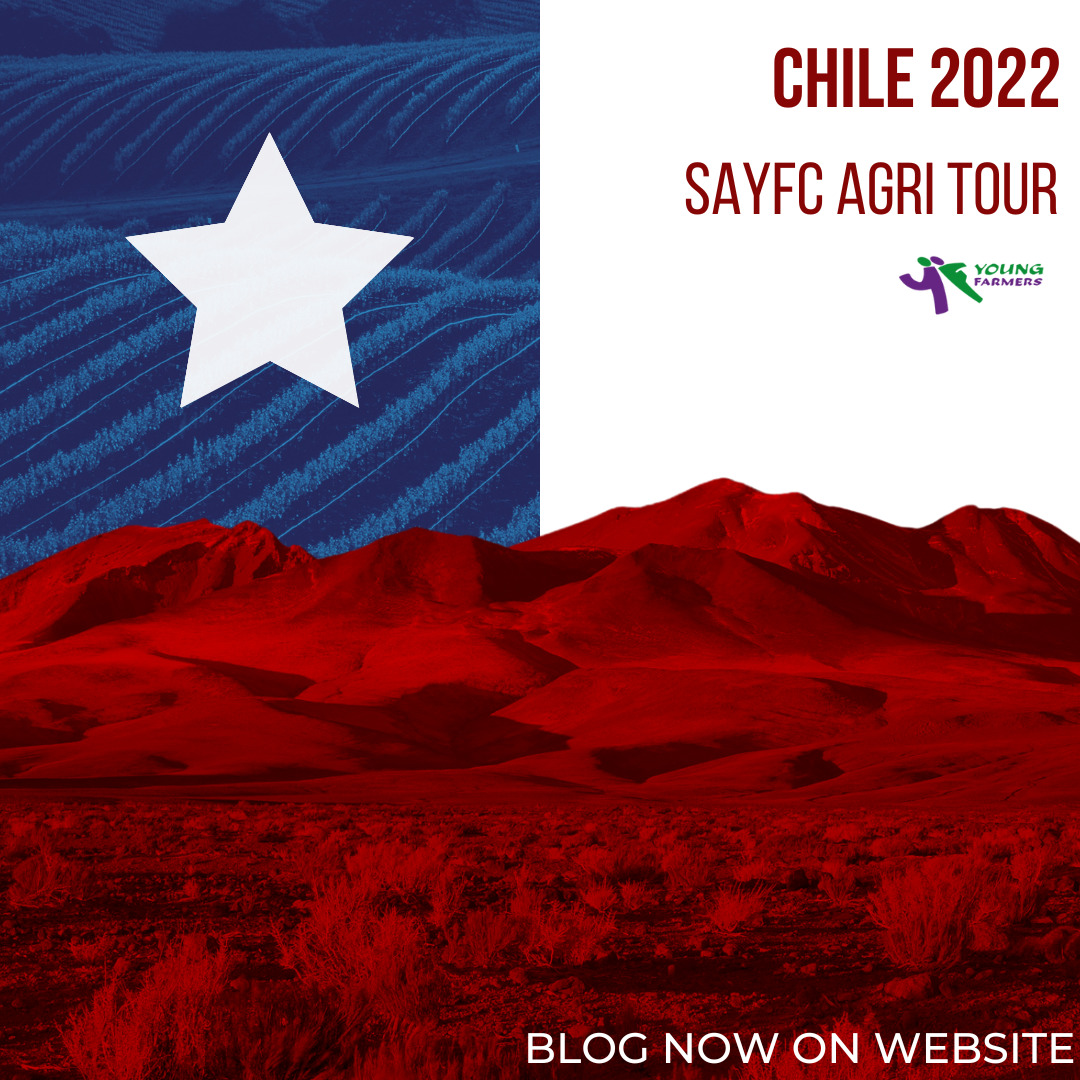
05 Dec Chile 2022- Agri Tour Blog
Day 1: Settling into Santiago
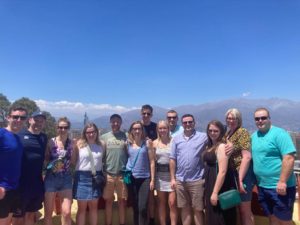
After a long flight the group arrived in Santiago and got situated in the hotel. The group had a free day in the city and climbed Santa Lucia hill for panoramic views over the city and across to the Andes.
Hamish Logan
Day 2: Talca Fruit Farm Tour
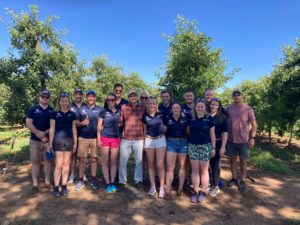
And we’re off! We kicked off the 2022 SAYFC Agri-Affairs Study Tour by heading South from Santiago to Talca, a key fruit growing region. We were hosted by Cesar Beltran Copefruit, a family business consisting of several farming sites, as well as a packhouse, processing plant and an export business. We visited one of their apple and cherry farms, consisting of 147 ha of orchards set in the shadow of the Andes mountains.
They produce a range of apple varieties, including Envy, Granny Smith, Brookfield (Gala) and Pink Lady, with about 70% exported to Europe and the rest going to the US and Brazil. Trees are grown at approx. 1.5 m spacing with branches tied to wire frames. A 4 ha trial was done to test a new method where trees are grown out to alternate sides, rather than vertical. This increases the yield on some varieties from 65 t/ha to 85 t/ha due to increased light penetration. Following a successful trial, they planted another 32 ha of orchards.
Apple trees begin production in the 3rd year, peaking in yield at year 5 and staying productive for 20+ years. Yields are carefully managed since over production one year will limit production the next. Trees are self-pollinating, requiring alternating varieties – e.g. 3 rows of gala either side of 1 row of pink lady. Prior to apples, kiwi fruits were grown but a difficult export market drove the decision to switch to apples. In each blossom, flowers are removed leaving 1-2 flowers to maximise colour and calibre of fruit. Apple production is heavily reliant on pesticides, with 20 applications per year, mostly of fungicides. The key pathogen is venturia – a fungus that affects fruit appearance. Nets are used to reduce the light intensity on the trees, which are placed on the ground nearing harvest to maximise light and enhance fruit colour. All trees are irrigated with liquid fertilizer applied through the irrigation. Sprinklers are traditionally used which supports clover cover crops in alleyways, although to reduce disease risk this is transitioning to drip irrigation. Water is available through a series of canals that collect melt water from the Andes. Fruit harvest occurs from mid Feb until early June, using migrant labour from Bolivia and Haiti. Prices are set by the exporters, but growers can typically expect $24 USD per 18.2 kg box. Harvest is a manual process, with fruit collected in baskets and sent to a nearby cold store for up to 4 months. The main spec considerations are fruit size, colour and sweetness.
We also saw cherry production, both newly planted and well-established sites. Young cherries become productive in year 3, producing 4 t/ha which rises to 12 t/ha by year 12. Production normally falls after year 15 but we saw cherries that were planted in 1999 and still producing 23 t/ha! They were sweetheart cherries, the earliest variety that the farm has, and were planted on an old method of bunds which are no longer used because they require ladders to harvest which adds cost. Cherry harvest begins in mid-December, with fruit picked between 06:30 and 13:30 because fruit becomes softer and more fragile during the hot afternoons. Nets are used on cherries to protect from heavy rain and high heat and helps ensure the earliest possible harvest. 93% of the cherries are exported to China, with the very earliest fruit transported by plane and later crops on boats.
The main challenge affecting the farm is access to water, which is already limited and becoming less available every year. The government supports by subsidising irrigation equipment, but much is beyond their control. This is likely to be a common theme as we continue our tour.
Ryan Douglas
Day 3: Merex Packhouse and Angus Soft Fruit Plantation
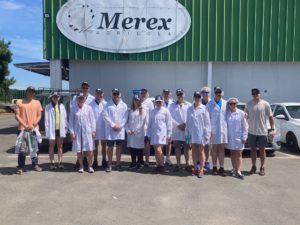
Visit two on Tuesday the 22nd of November. In the Morning we arrived at Merex Packhouse, a local family owned and run business who pack blueberries and cherries. In the afternoon we travelled to see an Angus Soft Fruit blueberry plantation to explore how they link their business in Chile with the headquarters back home in Scotland. The plantation is a joint venture with Merex.
The Merex family business use the best available equipment to grade and pack the fruit. As the season begins, the fruit is picked off the field early morning at 20°C and is instantly chilled through a blast chiller to 4°C. It is then stored in a chill room short term until needed. Both fruits are sent over an optical grader to pneumatically pick out the greens/rots/growth cracks and other defects, typically 10% grade off. This is a massive saving on labour and allows them to process up to 3.5t of cherries per hour and 1.8t of Blueberries per hour.
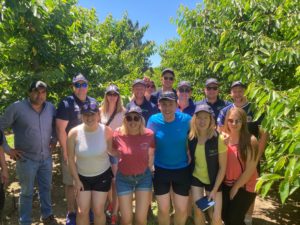
Angus Soft Fruit supply many of the major retailers in the UK. To secure year-round supply and offer themselves as an attractive customer, they source fruit from different growing climates with varying harvest periods. Chile lends itself perfectly for this, situated in the Southern Hemisphere, harvest season is December and January, right in the middle of UK winter.
Increased costs worldwide have tripled the price of shipping containers to $15,000 each. The complications of the pandemic have impacted the travel time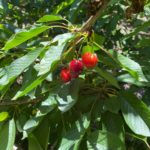 of blueberries. From when it gets picked in the field in Chile to when it hits UK consumer shelf, it currently takes a staggering 50 days in refrigerated packing and transport! This adds a huge cost to what is a relatively cheap crop to grow with a cost of production of only $2/kg. This plantation is 100ha and started in 2017. It is a way to start its 2nd crop with and estimated yield of 5t/ha and a future forecast of 20t/ha in a few years’ time. Water here was not much of an issue with 2 boreholes on site and a river nearby. It is situated east of the main road, towards the Andes where it is easier to access groundwater due to a larger water table below. As this plantation was designated for the UK market, it has to adhere to the global gap and Sedex accreditation schemes.
of blueberries. From when it gets picked in the field in Chile to when it hits UK consumer shelf, it currently takes a staggering 50 days in refrigerated packing and transport! This adds a huge cost to what is a relatively cheap crop to grow with a cost of production of only $2/kg. This plantation is 100ha and started in 2017. It is a way to start its 2nd crop with and estimated yield of 5t/ha and a future forecast of 20t/ha in a few years’ time. Water here was not much of an issue with 2 boreholes on site and a river nearby. It is situated east of the main road, towards the Andes where it is easier to access groundwater due to a larger water table below. As this plantation was designated for the UK market, it has to adhere to the global gap and Sedex accreditation schemes.
Buying land in Chile is very difficult with virtually nothing on the market. Prices are varied depending on location and water access. The average farm size is 50ha.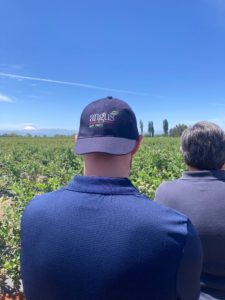
Chilean blueberry farmers main concern is the competition from Peru. The Peruvian harvest kicks off at the end of January and lasts for 9 months due to their tropical climate. As soon as this happens, the price of blueberries falls dramatically. This gives Chile a very small market window, much like the blueberry market back in the UK.
 In the months of December and January, blueberry farmers find it difficult to find enough labour as they have the same harvest window as cherries which are considered easier work. Questions were asked about the minimum wage for the area, with mixed answers, it was understood to be $3.50/hr.
In the months of December and January, blueberry farmers find it difficult to find enough labour as they have the same harvest window as cherries which are considered easier work. Questions were asked about the minimum wage for the area, with mixed answers, it was understood to be $3.50/hr.
At the end of the visit, we stopped at a 37Ha walnut plantation. Harvest is in April with yields of around 9t/Ha. 80% of the crop is exported to Asia in 25kg bags, 15% to Europe and 5% elsewhere. Pruning is a major part of the growing process taking place post-harvest. This stops the tree from becoming too big which would then reduce the quality of the nut. The tree needs 30mm of water every 10days via jet-line irrigation. One of the main concerns is heavy rain 2 weeks prior to harvest, where the brittle walnuts can be destroyed.
It is clear that every farmer and every crop faces their own challenges and it’s great to see different remedies and practices to overcome these specific problems.
Angus Dowell
Day 4, Earthquakes and Blueberries
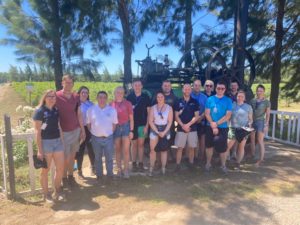
Today kicked off with a rumble, a 5.0 magnitude earthquake at about 6am seemed to have been the topic of conversation at breakfast, although Hamish and myself must be the deep sleepers of the group as we were unaware it had happened!
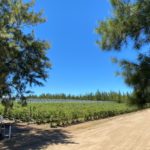 After a couple of fruity days around Talca, we had one of our biggest days of travel as we headed south for roughly 420 miles to Osorno. With a stop after about 170 miles (3 hours) on the outskirts of Los Angeles to visit S&A fresh produce to see their blueberry production.
After a couple of fruity days around Talca, we had one of our biggest days of travel as we headed south for roughly 420 miles to Osorno. With a stop after about 170 miles (3 hours) on the outskirts of Los Angeles to visit S&A fresh produce to see their blueberry production.
It’s always easy to get your bearings when on the road, as to the East the view of the Andes is amazing. As we travelled south it was clear to see the change in the climate and landscape. Around Santiago and Talca there is a lot of fruit production due to the hot weather, but very little in the way of vegetation. The further south we got the more trees, grass and cereals.
S&A are a company based in Hereford, England that was set up in 2010. They purchased the farm we visited in 2015 and this is their only farm in Chile. The main reason for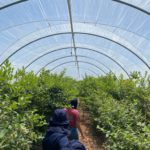 this expansion is to secure fruit supply for 12 months of the year to the UK and Europe. Typical harvest is from November to January, then Spain starts harvest January/February and then the UK kicks off after that. So, for S&A they have a 12-month supply of fruit. Chile was the first country in South America to grow blueberries, Peru has also started but the quality is not as good. In Peru there is not a big enough difference between the day and night temperature, but in Chile it is cold during the night and very hot through the day. The change in temperature gives the fruit good acidity and sugar levels, so Chilean fruit is very sweet and meets the global demand.
this expansion is to secure fruit supply for 12 months of the year to the UK and Europe. Typical harvest is from November to January, then Spain starts harvest January/February and then the UK kicks off after that. So, for S&A they have a 12-month supply of fruit. Chile was the first country in South America to grow blueberries, Peru has also started but the quality is not as good. In Peru there is not a big enough difference between the day and night temperature, but in Chile it is cold during the night and very hot through the day. The change in temperature gives the fruit good acidity and sugar levels, so Chilean fruit is very sweet and meets the global demand.
The farm we visited is run by the farm manager Rodrigo, who’s English is very good due to the fact he is in frequent contact with the UK. When they first purchased the farm there was 30Ha of blueberries, yielding around 300T a year. But now they grow 54Ha and have more than doubled production to 650T.
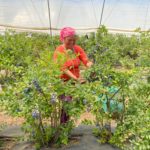 To set up blueberry production it costs about 50,000 dollars per Ha. Land costs are around $30,000 USD with a further $5,000 on water rights and $130,000 on fertiliser and chemicals.
To set up blueberry production it costs about 50,000 dollars per Ha. Land costs are around $30,000 USD with a further $5,000 on water rights and $130,000 on fertiliser and chemicals.
You don’t receive any return for the first 2 years, as it takes 3 years for a crop to grow on the plants.
Pruning is a huge part of blueberry production. This is where they remove a lot of the older growth, and branches that are at least 3 years old. This process promotes the plant to produce new growth and this is ideal for keeping a consistent yield. They apply nitrogen in 3 stages, pre harvest, during and post harvest, as well as other trace elements.
Irrigation is a huge part of blueberry production, this farm was fortunate to have water rights. They can extract 150L per second from the nearby river. They also use the water during the colder nights to prevent frost. This can cost up to $1,000 per night, but fortunately this year they have only had to use this twice. In previous years it has been up to 15 nights. The cost of establishing this frost prevention is near $1.5 million.
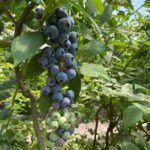
They have 11 full time staff on the farm, and in peak harvest season they employ 450 pickers. They are all paid a base rate per day, and 50p per kg on what they pick. It is made up of 60% females, with those aged between 35 and 50 being the most productive. The farm hires buses to travel to local towns to pick up the pickers, they can come from as far as 50km away.
Cost of production is around £2 per kg, and they receive £2.50 when sold. Majority of the crop is exported by boat to Europe via the Netherlands. It can take up to 50 days from harvest until it reaches the consumer.
After the visit we travelled further south to Osorno, this region is slightly milder than we have experienced so far and has higher rainfall.
Ally Brunton
Day 5, Nuts about Steak
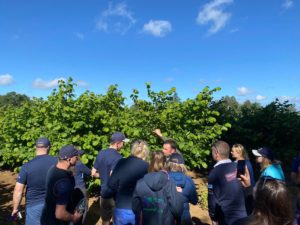
On the morning of Thursday 24th November we travelled to a farm on the outskirts of Osorno. This was the home of Nefuen Trading, which grows hazelnuts and cherries in the local area.
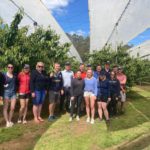 The farm which we visited first had been within the family for 6 generations and used to be the family dairy farm. It is now home to the main hazelnut operation after the current farmer, Jorge Mohr went to university and realised he could grow hazelnuts in this area of Chile. There is currently around 50 hectares of hazelnut trees on this site, with the first trees being planted when the family first went into fruit production in 2002.
The farm which we visited first had been within the family for 6 generations and used to be the family dairy farm. It is now home to the main hazelnut operation after the current farmer, Jorge Mohr went to university and realised he could grow hazelnuts in this area of Chile. There is currently around 50 hectares of hazelnut trees on this site, with the first trees being planted when the family first went into fruit production in 2002.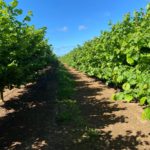 It can take $10000-$11000 to set up a hectare of land for hazelnuts. There is very little profit in the first few years because production on young trees is low, however when the trees come into full production in year six, yields can increase to 4 tonnes per hectare.
It can take $10000-$11000 to set up a hectare of land for hazelnuts. There is very little profit in the first few years because production on young trees is low, however when the trees come into full production in year six, yields can increase to 4 tonnes per hectare.
This farm is only 75-80m above sea level and gets an average rainfall of 1.3m. The hazelnuts are harvested in March/April using specialised machinery and any crop which falls on the ground is raked up and lifted. Due to the heavy use of machinery, labour requirements are typically very low, with a member of staff only being required every 15-20ha.
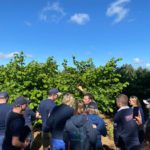 Hazelnuts are then taken to a gas drier and dried to 6%. They can then be stored for up to 8 months and any hazelnuts which are smaller than 20mm are cracked and sold to Ferrero Rocher. Ferrero buy 90% of the hazelnuts produced in Chile. Hazelnut trees can last well over 20 years and pay back usually occurs in year 8. This farmer makes around $6000 profit per hectare per year from hazelnuts. A drip line irrigation system has been installed and this is used to water and fertilise all plants. Water rights are bought from the government and paid for in litres per second. Another side to the business is the nursery where they grow new hazelnut plants to sell to other growers. There are around 4000 hectares of hazelnut trees planted in Chile every year and this company currently holds a 35% market share of the industry.
Hazelnuts are then taken to a gas drier and dried to 6%. They can then be stored for up to 8 months and any hazelnuts which are smaller than 20mm are cracked and sold to Ferrero Rocher. Ferrero buy 90% of the hazelnuts produced in Chile. Hazelnut trees can last well over 20 years and pay back usually occurs in year 8. This farmer makes around $6000 profit per hectare per year from hazelnuts. A drip line irrigation system has been installed and this is used to water and fertilise all plants. Water rights are bought from the government and paid for in litres per second. Another side to the business is the nursery where they grow new hazelnut plants to sell to other growers. There are around 4000 hectares of hazelnut trees planted in Chile every year and this company currently holds a 35% market share of the industry.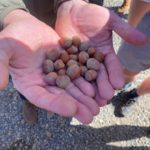
We then moved to another farm which would be around 5 miles away. This farm is where the farmer grows cherries in partnership with family members and other farmers. We could immediately see that this was a very different set up from the Hazelnuts as the majority of the cherry trees were covered with a continuous tarpaulin sheet roof. They started growing cherries here in 2008 and there is currently 55ha of Cherries being grown on this farm. Once we walked under one of the covers, we could see that drip line irrigation was being used. The farmer has rights to pump water straight out of the river which runs along the side of the farm. He uses that water to irrigate the plants and similarly to the other farm, the irrigation system is used to fertilise the plants. The plants under the covers look like they are overgrown, however they are pruned every 2/3 years to keep them tidy and also to ensure peak production. Bee boxes had been placed under some of the trees. These are rented to the farm by local beekeepers and ensure that pollination occurs. This is an incredibly important process for the production of cherries.
Cherries are currently growing on the trees, but they are not yet big enough or ripe enough. Cherries are harvested by pickers in mid-late January. 120 pickers are normally involved in this process. Unlike the farms we have visited so far, professional pickers are hired for this process, with some of the best pickers harvesting around 400kg per day. The majority of the pickers are Chilean; however, many are also brought here from Peru for the season. Some of the best pickers can typically earn up to $100 per day. The tarpaulin covers ensure that the crop is protected from rainfall. This is important, as if rain falls on the plant on the run up to harvest, the cherries go soft and split. This can typically ruin up to 40% of the crop and seriously affect profits. They are careful to ensure that only ripened cherries are harvested as unlike other fruits, they do not ripen after they have been picked. After harvest, the cherries are put into cold storage on the farm and then transported to outlets when required. Cherries are colour graded in order to decide which countries they are sold to, with each market preferring different shades of red. The UK tends to prefer a deep red.
This company currently has around 700 hectares of hazelnuts and cherries in production across Chile and currently receives no government support with any part of the business. After lunch we then went to visit a Cranberry farm near Paillaco. This is owned by the Ontario Teachers’ Pension Fund who bought the farm from American shareholders in 2021.
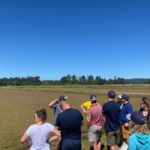 None of us expected what we saw. This was an incredibly flat farm in the valley with lowered seed beds or ‘bogs’ for as far as the eye could see. This farm stretches over 133 hectares, and each bog is 0.5 hectares, featuring a series of drains and channels. Due to the high level of sculpting and inputs required, each bog takes $10000 to set up. The land here is high in nitrogen and organic matter due to volcanic ash and Cranberry plants are planted in a 15cm bed of sand which is added on top of the original soil. The plants are planted at a rate of 300 plants per square foot. Cranberries are a perennial crop which lasts all year. Liquid fertiliser and irrigation is carried out through a series of sprinklers in each bog. Similar to the last farm, water is extracted from the river and stored in reservoirs until required.
None of us expected what we saw. This was an incredibly flat farm in the valley with lowered seed beds or ‘bogs’ for as far as the eye could see. This farm stretches over 133 hectares, and each bog is 0.5 hectares, featuring a series of drains and channels. Due to the high level of sculpting and inputs required, each bog takes $10000 to set up. The land here is high in nitrogen and organic matter due to volcanic ash and Cranberry plants are planted in a 15cm bed of sand which is added on top of the original soil. The plants are planted at a rate of 300 plants per square foot. Cranberries are a perennial crop which lasts all year. Liquid fertiliser and irrigation is carried out through a series of sprinklers in each bog. Similar to the last farm, water is extracted from the river and stored in reservoirs until required.
To harvest the cranberries, they flood the bog with water to a height of around 15-20cm above the plant. They then use a mechanical structure called a bridge to straddle the entire bog. This bridge has a section on it with tines and it is dragged through the water in order to shake up the plants. Cranberries are then knocked off the plant and rise to the top of the water. A rope is then used to drag all of the cranberries to one corner of the bog where a conveyor separates the crop from any water and trash. The fruit is then transported 100km by lorry to a complex where it is processed. The bogs have been designed in a way which allows the water to be moved through channels and used to flood the next bog.
There are 10 full time staff and 18 part time staff on farm and harvest takes two months from April to June. Similar to other fruit crops we have seen so far, the plants require pruning in order to maximise production. Optimum production can be as much as 50 tonnes per hectare.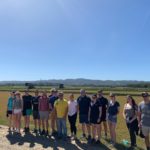 The farmer explained to us that the demand for Cranberries had sky-rocketed since Covid, with people believing that they hold extremely healthy properties, and they are a health food. Due to an increased global demand, this farm has just invested in 15 more bogs. The value of the cranberries has increased from $32 per barrel to $50 per barrel.
The farmer explained to us that the demand for Cranberries had sky-rocketed since Covid, with people believing that they hold extremely healthy properties, and they are a health food. Due to an increased global demand, this farm has just invested in 15 more bogs. The value of the cranberries has increased from $32 per barrel to $50 per barrel.
All cranberries from this farm go to OceanSpray to produce fruit juice and dried fruit for fruit mixes. These are long term contracts which have given the farm security and confidence to invest.
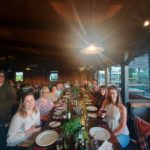 The main concerns on this farm are the cost of diesel, paying salaries and the cost of fertiliser. This country also has a new government, and this farmer is concerned that it will not do enough for agriculture. Very similar concerns to home but on a massive scale.
The main concerns on this farm are the cost of diesel, paying salaries and the cost of fertiliser. This country also has a new government, and this farmer is concerned that it will not do enough for agriculture. Very similar concerns to home but on a massive scale.
On Thursday evening we visited the first steakhouse of the trip in Osorno. The steaks were cooked on an open fire grill, and it was a fantastic advert for the quality of meat and agriculture in this country. This will lead very well into our first livestock visit tomorrow……
John McCulloch
Day 6: El Reinal Farm and Porto Varis Market
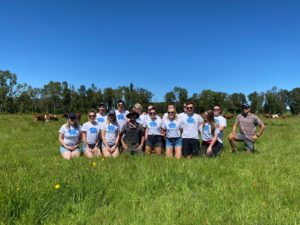
Hola amigos from the middle of a very rich green grass field on El Reinal Farm which is a regenerative Beef farm which is all Red Angus Cattle. We left Osorno this morning and travelled for 2.5hours, seeing a lot more mixed farm practices just like home. A lot of dairy coos were seen, and oceans of grass. Grass everywhere.
The farm was purchased by Auction and has expanded since. The farm was purchased by Matias’ father 38 years ago. Originally from Santiago he had no farming background and
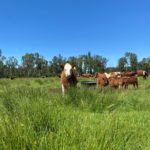
worked making credit cards. They wanted to get out of the city, so all the family moved to the farm.
700hectares of Pasture and 500 hectares of forestry was purchased and split over four farms all relatively close to each other. On one of the Farms, we visited there are 100 grazing paddocks which the stock are rotated and moved every day. The farm has not used fertiliser or any tillage since 2016. They make 3000 bales of silage to feed the coos which are rolled out across the field not in feed rings. The farm was originally a dairy, but the family stopped production 10 years ago because it was not making money.
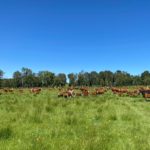
He kept all the coos and crossed them with the fleckvieh and now everything goes on to the Red Angus. He calves 400 cows which are born from September to November all outside and he weans the calves at 6months old, and the bullocks and heifers are split over the different farms. He breeds his own replacement heifers which are bulled at two years old. There is only one full time stockman, and the machinery is very basic.
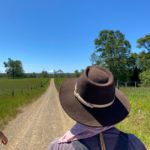
To generate income, he did contracting for 4 years to help expand the farm. At this point he analysed the farm and wanted to produce a premium product which he enjoyed not what the consumer wanted. Matias didn’t like the thought of cattle being pushed on heavy weight diets at feed lots, so he went to California to Wild Oaks
which he described as “the Disneyland of regenerative agriculture” to learn about rearing cattle from grass, processing it and finding a market for the beef. Matias’s goal is to produce the safest meat produced in the world and for customers to trust him with his USP being “the only way to sell is trust”. There is only 2 slaughterhouses and he found it very difficult to establish a network but eventually a breakthrough happened and now kills 20 bullocks a month which is an increased by a fifth from four years ago. Recently the beef is now being sold to Jumbo (similar to Tesco!) which is a major supermarket and sells online too. All the online delivers are done by him personally as he feels this is the best way to engage with his clients. He sells everything from the animal, the bones, hide and tongue. El Rino the brand is sponsored by Patagonia Clothing brand.
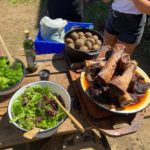
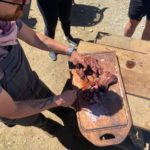
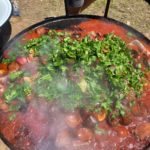 After the farm tour Matias cooked us an amazing 3 course lunch which was from a Chilean BBQ and fire stove all outside. We had Chizo sausage with red onion and tomato sauce, Steak and Beef shank, salad and tatties. It was a beautiful setting, and there was quite a lot of red sunburn when we finished up. Overall, we took away from this visit that Matias was “not money driven, but money fuelled, and passion driven”. He aims to enjoy what he does on the farm and ensures the family are on the journey with him.
After the farm tour Matias cooked us an amazing 3 course lunch which was from a Chilean BBQ and fire stove all outside. We had Chizo sausage with red onion and tomato sauce, Steak and Beef shank, salad and tatties. It was a beautiful setting, and there was quite a lot of red sunburn when we finished up. Overall, we took away from this visit that Matias was “not money driven, but money fuelled, and passion driven”. He aims to enjoy what he does on the farm and ensures the family are on the journey with him.
The next stop for us was a home away from home for me the livestock Auction Market. When we arrived, there was not a sole going about, so I went to the cafe and found the auctioneers. They very kindly gave us a tour of the market and I got to sell a Cull cow which was in the ring and Marcos the auctioneer sold one too in Spanish and the sale report for the day was: “Cull cows continue to sell at excellent rates with buyer demand outstripping numbers on offer” The market was at Porto Varis owned by Fegosa, they also own another 3 auction markets with Perto Mont being the biggest Cattle market they own. They sell 70% of cattle in the region and 25% of the overall market share in Chile. They sell cattle everyday between the auction sites. They have two rings going at the same time with heifers sold on side of market and males at the other side taking time about. Porto Varias sells roughly 400 cattle per week on a Thursday. There was also lairage facilities at the market and huge walkways above all the pens so everyone could see the animals. All cattle are EID tagged and read in the mart. Trade currently just now is $2 per kg live weight for a fat bullock.
The market was at Porto Varis owned by Fegosa, they also own another 3 auction markets with Perto Mont being the biggest Cattle market they own. They sell 70% of cattle in the region and 25% of the overall market share in Chile. They sell cattle everyday between the auction sites. They have two rings going at the same time with heifers sold on side of market and males at the other side taking time about. Porto Varias sells roughly 400 cattle per week on a Thursday. There was also lairage facilities at the market and huge walkways above all the pens so everyone could see the animals. All cattle are EID tagged and read in the mart. Trade currently just now is $2 per kg live weight for a fat bullock. 
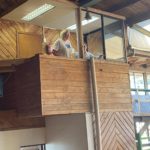 Red Angus cattle are most popular breed of animals they sell, and animals are sold by their teeth composition rather than what they are. Breeding bulls are sold farm to farm, with all classes of livestock being charged a 5% commission and payment on 30days after the sale. The Pandemic was very good for the trade just like back home however 80% dairies have stopped production and the bigger farms have gotten bigger. The have exported 7000 live cattle to China recently.
Red Angus cattle are most popular breed of animals they sell, and animals are sold by their teeth composition rather than what they are. Breeding bulls are sold farm to farm, with all classes of livestock being charged a 5% commission and payment on 30days after the sale. The Pandemic was very good for the trade just like back home however 80% dairies have stopped production and the bigger farms have gotten bigger. The have exported 7000 live cattle to China recently.
At the end of the tour, I was presented with the Auctioneers Gaval which was a real treat and a few tears shed by all in the group!
Now we are off Porto Varias to check in to the hotel and taste the night life.
Gemma Dugid
Day 7: Vergara Family potatoes
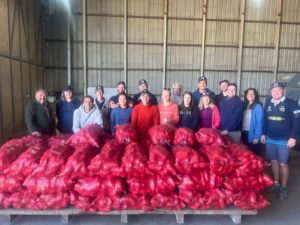
If Gemma Collins can’t have any carbs before ‘Marbs’ then she best not visit Chile. The plates of chips they serve with most meals are not too dissimilar to the Andes Mountain range – although the Andes may actually be slightly smaller. This is clearly a country that is in love with the potato and what they can make with them.
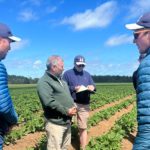 It is therefore fitting that on Saturday 26th November we travelled 1.5 hours north from Puerto Vares to one of the nicest farms I have ever seen. Owned and farmed by Matias Vergara it was an 800ha arable farm growing 180ha of maincrop potatoes with the remainder being down to Wheat; OSR; Barley and Oats. The landscape flat (prairie like), the soil volcanic and the water available it is a recipe for some fantastic yields of potatoes. The farmer grew only 2 varieties of potatoes in the form of Asterisk and Mozart. Both of which destined for the tables of Santiago in 25kg bags. He was achieving some of the biggest yields I have ever seen, ranging between 75 and 85t/ha!
It is therefore fitting that on Saturday 26th November we travelled 1.5 hours north from Puerto Vares to one of the nicest farms I have ever seen. Owned and farmed by Matias Vergara it was an 800ha arable farm growing 180ha of maincrop potatoes with the remainder being down to Wheat; OSR; Barley and Oats. The landscape flat (prairie like), the soil volcanic and the water available it is a recipe for some fantastic yields of potatoes. The farmer grew only 2 varieties of potatoes in the form of Asterisk and Mozart. Both of which destined for the tables of Santiago in 25kg bags. He was achieving some of the biggest yields I have ever seen, ranging between 75 and 85t/ha!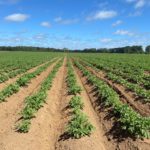
They plant the spuds between September and November and lift between January and April. All of the seed is bought in. The potato planter can go straight into the field once it has been prepped. No need for deep ridgers and stone separation here. Once the potatoes have emerged, they then ridge up the ground into the drills as we know them. The blight and irrigation programmes are fairly similar to home with roughly 9 blight applications and as much water as the plants need. Water is sourced from boreholes and is applied via pivot, gun and drip. Hey can keep some of the potatoes in the soil here to cure and this saves on storage costs. Slightly different from harvest in Scotland where we like to get them out the ground pronto. All of the potatoes are harvested by machine on this farm. Although this is not the case for all of the potato production in Chile with a portion of growers still harvesting by hand.
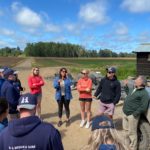 Matias is different from other Chilean growers in that they pack and market all of the potatoes themselves. This means they can achieve the best prices in the marketplace of between $300 – $400/ ton. Most growers in Chile use merchants and do not achieve prices anything like that. His margin per ton is roughly $100 – $200 so this means that each Ha will net no less than $7,500. A very impressive figure and this has meant that over the past 30 years the Vergara family have been able to expand from 150ha of ground to the 800ha they currently have.
Matias is different from other Chilean growers in that they pack and market all of the potatoes themselves. This means they can achieve the best prices in the marketplace of between $300 – $400/ ton. Most growers in Chile use merchants and do not achieve prices anything like that. His margin per ton is roughly $100 – $200 so this means that each Ha will net no less than $7,500. A very impressive figure and this has meant that over the past 30 years the Vergara family have been able to expand from 150ha of ground to the 800ha they currently have.
One thing that struck me was the fact they could grow potatoes every 1 in 4 years and PCN was not a problem. It could be something to do with the fact that OM in the soils ran between 15 – 20% but we couldn’t confirm this. Powdery and common scab and Rhizictonia are a problem in Chile just as they are at home. With the volcanic soils nutrient block can be a problem and this means that production costs can be slightly higher due to the amount of fert required.  We then went on to talk about the cereals and OSR on the farm where they were also achieving very good yields with Wheat at 12t/ha, OSR at 6.2t/ha, barley at 9t/ha and oats at 11 t/ha.
We then went on to talk about the cereals and OSR on the farm where they were also achieving very good yields with Wheat at 12t/ha, OSR at 6.2t/ha, barley at 9t/ha and oats at 11 t/ha.
We all left very impressed by the figures of the farm, and I am sure there will be lessons learned to take back home to Scotland.
Matthew Steel
Day 8: Vicente Pérez Rosales National Park
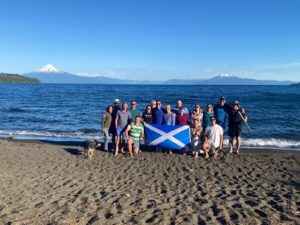
We started the day off by visiting the Vicente Pérez Rosales National Park which was created in 1926 and it is the oldest park in the country. We walked round the park viewing the volcanoes, mountains, forests of native trees and beautiful lakes. Its wonderful scenery makes the park a top tourist attraction.
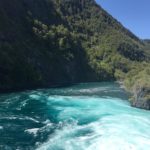 On six day we went to see a farm that practices regenerative agriculture, and on that visit, we met a Dutch farm apprentice. She enjoyed spending time with us and as a result she used her day off work to come on our day out.
On six day we went to see a farm that practices regenerative agriculture, and on that visit, we met a Dutch farm apprentice. She enjoyed spending time with us and as a result she used her day off work to come on our day out.
Our tour guide, Lucas, kindly invited us to spend the day at his family holiday home on a local farm so we went to a supermarket to buy food for a BBQ. It was very interesting to see the differences between a typical Chilean supermarket compared to a British supermarket. One difference that stood out was that the meat which was labelled “grass fed” had a separate section within the supermarket and it demanded a higher price. We also noticed that unlike the UK there were no convince foods, highlighting the difference in our food culture.
The scenery at the farm was also beautiful as it was next to a lake with views of mountains and volcanos in the distance. We had the pleasure of meeting Lucas’s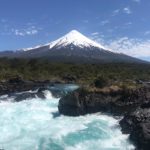 family who dined with us. In 1983, his father’s family moved from the UK to Chile.When they arrived in Chile, they set up a biscuit company called McKay which in 1968 was sold to Nescafé. The brand name is still very well known in Chile. His father started up a blueberry farming business and ran this during his working life.
family who dined with us. In 1983, his father’s family moved from the UK to Chile.When they arrived in Chile, they set up a biscuit company called McKay which in 1968 was sold to Nescafé. The brand name is still very well known in Chile. His father started up a blueberry farming business and ran this during his working life.
They cooked the food we brought, and we noticed that they had a very relaxed and sociable approach to preparing the food. The meat went on the BBQ at different times throughout the day and was cooked slowly. It was then dished up on a platter for people to pick away as they wish. 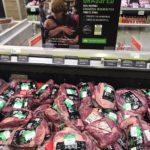 On this trip I think we have all appreciated that Chileans tend to be more patient than us with regards to preparing and cooking food and they place importance preparing it to a high standard.
On this trip I think we have all appreciated that Chileans tend to be more patient than us with regards to preparing and cooking food and they place importance preparing it to a high standard.
We spent some time swimming in the sea and overall had a brilliant day. We were incredibly lucky to have been invited into their home and again have the opportunity to speak to and learn from influential people within the Chilean agriculture industry.
Lucy Mitchell
Day 9- Sheep and Cattle Visits
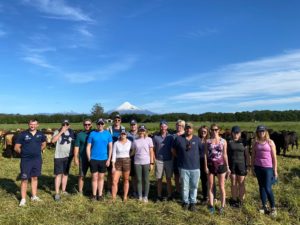
Monday the 28th began by traveling just an hour out of Porto Varis to meet Daniel & Armin Claro, a father & son duo farming 1500 ewes on a 100-hectare hill farm. The farm sits 80m above sea level & receives 1.5m of rain – so not dissimilar to some parts of Scotland. The soil structure is similar to NZ; acidic with a high content of volcanic ash which means it is very fertile & free draining.
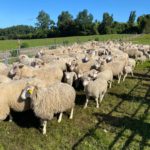 The father Daniel studied livestock nutrition & genetics in New Zealand in 1965 & spent 3 years working there with farmers & in research labs studying sheep breeds & productivity traits. It was this experience that taught him to establish his own breed of sheep comprising of 40% Friesian – a very prolific sheep breed which can produce up to 600L of milk/year & also produces a very lean meat. The remaining genetics comprise of 20% Texel, 20% Dorset & 20% border Leicester. The ewes weigh roughly 75kg, & closely resemble a meat merino.
The father Daniel studied livestock nutrition & genetics in New Zealand in 1965 & spent 3 years working there with farmers & in research labs studying sheep breeds & productivity traits. It was this experience that taught him to establish his own breed of sheep comprising of 40% Friesian – a very prolific sheep breed which can produce up to 600L of milk/year & also produces a very lean meat. The remaining genetics comprise of 20% Texel, 20% Dorset & 20% border Leicester. The ewes weigh roughly 75kg, & closely resemble a meat merino.
Lambing takes place for the entire month of September, & all ewes are put on a hormone synchronisation programme to tighten the lambing period. Synchronisation means the farm can work much more efficiently, utilising staff & grass availability. All lambs are tagged with electronic tags at birth, which allows Armin, an engineer to trade, to record birth weight, daily live weight gains & retain females from good maternal lines. Tup lambs for breeding are selected on 100-day DLWG & are either retained for breeding, sold at the farm gate to dealers & breeders or sold for slaughter.
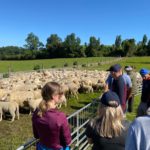 Females are selected on their tupping weight. The family aim to produce lighter sheep with bigger lambs – roughly 18 – 20kg dead weight & are continually pushing their live weight gain potential through careful genetic selection & nutritional properties of the grass.
Females are selected on their tupping weight. The family aim to produce lighter sheep with bigger lambs – roughly 18 – 20kg dead weight & are continually pushing their live weight gain potential through careful genetic selection & nutritional properties of the grass.
Ewes achieve a 190% lambing percentage, & hoggs 140%. 200 replacement ewe lambs are kept every year & the rest sold to other breeders or fat. High sale season is in December prior to Christmas, so wheat or oats are supplemented to push lambs on, & permanent pasture includes chicory to provide energy for growing & ewes pre & post lambing.
In the afternoon we met Jordan who is a trained veterinarian, & now works as a cattle dealer rearing calves for slaughter & selling farm equipment. He learnt the hard way when he first began farming, after building a feed lot for 800 bull calves to finish intensively on pit silage. Due to the harshness of the summer, & his commitments to other parts of his business he soon realised the quality of silage he was making was not good enough & he was not running a productive business. He invested in a McHale Baler, to give him flexibility with cutting dates & make a more manageable, higher quality forage.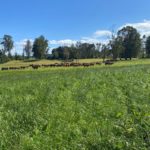
Across 3 farms, Jordan calves 250 of his own cows – a mix of AA, Hereford & Olbrich genetics, as well as buying in 3000 bull & heifer calves from southern Chile to finish on paddock strip grazing. Calves are bought between 180-220kg, & travel roughly 1000km from Punto Arenas across 3 days & through Argentina before arriving at the farm. Jordan aims to achieve 200kg DLWG in 1 year from grass & sells at 400kg for cattle to go further north & on to feed lots for slaughter. 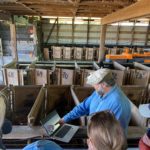 Between the months of April & May prime cattle come inside for 60-90 days to be intensively reared prior to festival time in September. This is the prime time of the year for selling cattle, so it pays to feed concentrates & push cattle on. A diet consisting of baled silage, ground maize, molasses & urea achieves an average 1.6kg DLWG. At the point of our visit the cost of beef cattle was $3.80kg LW.
Between the months of April & May prime cattle come inside for 60-90 days to be intensively reared prior to festival time in September. This is the prime time of the year for selling cattle, so it pays to feed concentrates & push cattle on. A diet consisting of baled silage, ground maize, molasses & urea achieves an average 1.6kg DLWG. At the point of our visit the cost of beef cattle was $3.80kg LW.
Jordan is also a distributor of 7 agricultural machinery brands, namely McHale. He supplies balers all over Chile & employs a team of engineers & hauliers to supply & service then. Jordan admits that the machinery business is worth 80% of his profit margin, & the cattle just 20%.
Annie Bryson
Day 10: Dairy Visit
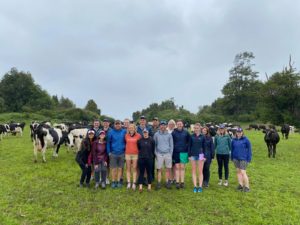
The first dairy visit of the trip had been the day the dairy farmers from the west had been looking forward to! However very fittingly it was the first wet day of the trip!
In the morning the group visited Jose, a Chilean, who is in his third year of a ten-year tenancy on a 130ha block of bare land just north of lake Llanquihuihue. He was paying £270/ha for this unirrigated land.
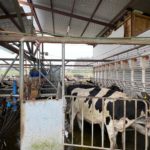 Jose is a professional hoof trimmer and took on the tenancy of the land three years ago with the plan of being able to oversee management of the farm with one employee whilst he remained hoof trimming full time.
Jose is a professional hoof trimmer and took on the tenancy of the land three years ago with the plan of being able to oversee management of the farm with one employee whilst he remained hoof trimming full time.
Having been inspired by the low input, New Zealand style system operated by the Chile’s biggest dairy farming business, Manuka, Jose has rebuilt a second hand 12/24 parlour on this greenfield site. Water, electricity and cow track infrastructure has also been installed but no winter housing has been built due to the mild winters and free draining volcanic soil in this area.
They were milking 160 cows and were buying in all of their dairy replacements and then selling the bull calves at 10 days old. The dairy heifers were being sold to China between 180-300kg for roughly £600. China is buying approximately 20000 dairy calves from Chile each year, sailing them over the Pacific in boats 5000 at a time.
The milk price here is around 37p per litre at the moment. In Chile there are five main milk processors, and this farm sold its milk to the largest one called Colon, a farmer owned Cooperative, which processes the milk to supply the liquid milk, cheese and yogurt markets within Chile. With a total national herd of 400,000 cows the vast majority of the milk in Chile in consumed within the country.
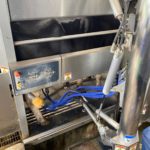 It was very interesting to see how Jose was managing the farm alongside the hoof trimming business which included selling hoof trimming products and distributing the KVK brand of crushes across Chile.
It was very interesting to see how Jose was managing the farm alongside the hoof trimming business which included selling hoof trimming products and distributing the KVK brand of crushes across Chile.
After a lunch of traditional Cazuela, a beef soup with pumpkin, rice, potatoes and sweet corn we travelled north to the outskirts of Osorno.
Our second visit of the day was to the Agricultural research institute of Chile (INIA).
This part government funded institute leads the sustainable development of the Agri-food chain in Chile.
We visited three research programmes throughout the afternoon.
Firstly, we visited a new experiment looking at the impact of climate change on different varieties of grass. Small 2 metre square open top glass chambers were used to create an environment which will be 1.5 degrees warmer than the control plots to simulate the possible effects of a warmer climate. Perennial Rye grasses where being trailed against Brome as it has been found to grow better in warm conditions compared to perennial rye grasses which show slower growth rates over 23 degrees Celsius.
The potential grass yield in this area is 16–17 tonne of dry matter per hectare and with it currently being late spring in Chile they were at peak grass growth.
The second trial we looked at was robotic milking with cows being out all year round on a 60 hectare ABC paddock system. The 180 cows were being milked through two Delaval robots. These holstein Friesian (by far the most popular breed in Chile due to German immigration in the past) were giving 7000 litres per year and eating 2 tonne of concentrate.
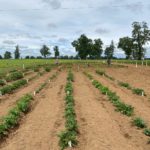
They were very impressed with the robots as the herd was being managed by two full time staff. We were surprised to hear that they managed to get 90 cows milking through each robot, but we found out that it was made possible by using out of parlour feeders to reduce time eating in the robot and the fact they were working on an average of 2.1 milkings per day.
The wide-ranging research institute then took us to a potato plot trial where they were breeding new varieties of potatoes for the growers in Chile. Then onto the research laboratory where they controlled a late blight alert system and did trials on the effectiveness of fungicides against diseases.
This busy day meant we were all ready for a sleep on the 9hr overnight bus journey north to the wine making region around Santa Cruz tomorrow…
Andrew McGregor
Day 11: History and Wine
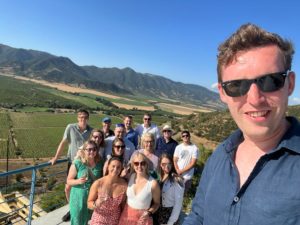
Fourteen very tired young farmers arrived in Santa Cruz on Wednesday morning after an eventful overnight bus journey. The day had every potential of being a slow one, however we ended up creating the some of the best memories of the tour.
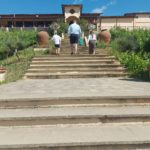 It is clear we have arrived in Chile’s wine region.
It is clear we have arrived in Chile’s wine region.
Having been in the country for 10 days, our learnings have been focused on agriculture, so studying the country’s culture in the broader term was welcome. The Museo de Colchagua gave us an insight into Chile’s history from prehistory up until the present, with impressive collections of precolumbian art, jewelry and tapestry. The history of Chile is complex and is deserving of their evident national patriotism.
Spain conquered and colonized the region in the mid-16th century, replacing Inca rule, but failing to conquer the independent Mapuche who inhabited what is now south-central Chile. In 1818, after declaring independence from Spain, Chile emerged in the 1830s as a relatively stable authoritarian republic. In the 19th century, Chile saw significant economic and territorial growth, ending Mapuche resistance in the 1880s and gaining its current northern territory in the War of the Pacific (1879–83) after defeating Peru and Bolivia. Some of the architecture is suggestive of German immigration post WW1 to the country. The highlight for many of the group were the exhibits relating to the Chilean miner rescue which occurred in 2010.
We then went on to one of the most anticipated tours of the trip, a vineyard. We are in the heart of the wine region of the Chile so it would be rude not to explore this sector of agriculture. At the Viña Santa Cruz we were able to explore the vineyards with an amazing view of the valley, with a cable car ride to the villages of some of the native people of Chile.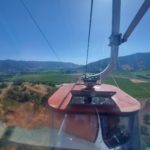 Established in 2003 and making wine since 2005 in Colchagua, Viña Santa Cruz has over 160 hectares of vines which are mainly focused on red Bordeaux and Mediterranean varieties. The philosophy of the brand “Body and Soul” was evident from the owner and tour guide, Carlos Cardoen, a businessman who loves the land & its traditions. The wines are inspired by the rituals and cultures and people of the Mapuche, Aymara and Rapa Nui.
Established in 2003 and making wine since 2005 in Colchagua, Viña Santa Cruz has over 160 hectares of vines which are mainly focused on red Bordeaux and Mediterranean varieties. The philosophy of the brand “Body and Soul” was evident from the owner and tour guide, Carlos Cardoen, a businessman who loves the land & its traditions. The wines are inspired by the rituals and cultures and people of the Mapuche, Aymara and Rapa Nui.
As the winery is relatively new, the cellar being 20 years old, there are high levels of technology, regulating temperature and humidity during the fermentation process and 10ha of drip irrigation. Most wineries in Chile use American oak barrels, however this boutique business prides itself in French oak barrels, producing 200k litres per year.
They grow different varieties of red grapes on this vineyard, including the Chilean native Carmenert. This area has summer temperatures which vary between 38°c during daytimes and 12°c at night, this fluctuation being perfect conditions for sugar production in the red grape.
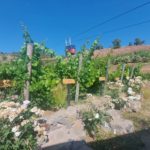 The Merlot variety is the first to harvest in April, with the Carmenart being the last to mature. Each plant shows off different colours at harvest making the vineyards especially beautiful during this time.
The Merlot variety is the first to harvest in April, with the Carmenart being the last to mature. Each plant shows off different colours at harvest making the vineyards especially beautiful during this time.
Carlos also described his new business venture, 10ha of avocado plants, the green gold of Chile. He planted this in August and will realise its first return in three years. The winery only uses 25% of it’s 130ha to produce grapes, diversifying in other fruits for export. The avocados are destined to market in Japan, China and Europe.
Typically, wineries in Chile export around 80% of their product, this one only exporting 10% (5k bottles) to Germany and Belgium, which certainly pushed sales in the gift shop after the tour. Overall, Chile is within the top 5 in the world for exporting wine.
It is clear that Carlos has huge pride in his product, describing his favourite wine as his blood. His over-arching message: have passion, pride and love what you do.
Joanna Foubister
Day 12: Vineyard Tour and Dinner with UN Agricultural Consultant
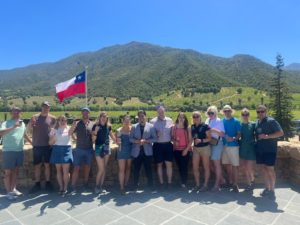
After our last (rather big) night as a group altogether we woke up on Thursday morning one less as Hamish flew home to pipe at a wedding.
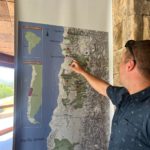
Montes have various vineyards spread all over the wine regions of Chile covering a total of 1800 hectares to allow them to make a variety of wines very well. Each grape needs different specific conditions which gives each wine varying amounts of complexity and so dictates how long they can stay in the bottle. 95% of their product is exported to 110 countries with Asia being their biggest market, Brazil taking 15% and Europe only around 7/8%.
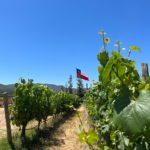
The main source of water comes from a small river that we crossed at the entrance, the Tinguiririca river. That is the only source of water for the vineyard here at the Colchagua valley. Montes vineyards have been using integrated management techniques in 100% of their vineyards since 2000. This includes the constant recording and monitoring of pests, diseases, natural enemies, and nutritional and water requirements to ensure the sustainable use of pesticides, fertilizers, and water. 60% of their vineyards retain a natural plant cover between the rows to decrease problems with erosion and soil compaction. This also encourages the proliferation of natural enemies of the pests that affect viticultural production. 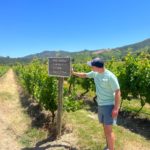
We continued our tour down into one of the barrel rooms, where the temperature is kept at 15 degrees Celsius at all times. Here we were met with song of Halo playing. Eric explained that one of the previous owners, Douglas Murray, really believed in the vibrations of the music and how these vibrations made the molecules move within the French oak barrels. 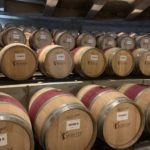
Here in this barrel room was what they call the Tayta. This is a wine that is only made when they have the perfect harvest, the last one was made in 2018 and the only person who knows what makes a perfect harvest is the wine maker. They say around 85% of the tayta is Cabernet Sauvignon and then the remaining 15% is the choice of the wine maker. One bottle of this costs around £250 and there are only around 3000 bottles per harvest, most of these are exported and only 100 bottles are left in Chile. This will last for 20 years in the bottle.
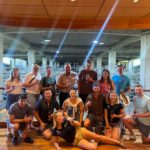 We had lunch at the vineyard where we were told to sip back and relax as we sat in the middle of the vines and were served a fine selection of food and wine. We then got back on the bus and travelled two hours north back to Santiago.
We had lunch at the vineyard where we were told to sip back and relax as we sat in the middle of the vines and were served a fine selection of food and wine. We then got back on the bus and travelled two hours north back to Santiago.
Once checked into our hotel in Santiago we went to go and meet a girl Sarah, who worked as an agricultural consultant for the UN, for some food and drinks – we had hoped to catch up with her earlier in the trip to visit her work, but the itinerary didn’t allow. Sarah is currently undertaking her PhD in cherries. It all comes down to size, colour, marketing information and she is trying to understand what percentage of each quality attribute is represented in the end price.
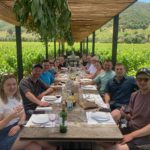
Throughout our time in Chile we’ve noticed a lot of tolls on the roads, this is because all of the roads in Chile are owned privately.
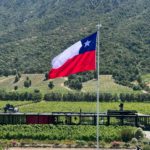
With that we also noticed significantly less pot-holes! We’ve also noticed a lot of the rivers seem very brown and dirty looking, Sarah explained that this would be because ice on top of the mountains is melting as they are coming out of spring into summer, and so this appears brown to begin with because the ground has been dried up for so long.
We had hoped to gain some more information about the UN and Sarah’s work within it however it seems that the Chileans don’t talk about business outside of the business and that restaurants should be for drinking and eating only. It’s the laidback Chilean way.
Linsey Campbell
Day 13: Final Day: Avocados
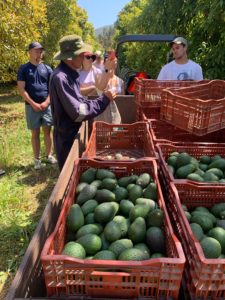
Friday morning saw the group depart for one final day of visits, this time heading to the north of Santiago to Crisol Farm where we were met by co-founder, Marcella. The drive north took us through another change in landscape where the dry climate and desert is clear to see.
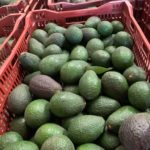 The farm benefits from a microclimate with the Andes to the east and the Pacific Ocean to the west.
The farm benefits from a microclimate with the Andes to the east and the Pacific Ocean to the west.
Crisol Farm extends to 9ha with 7ha planted for Organic Avocado production and the remaining 2ha providing grazing for livestock, a lake for water retention and a small market garden area growing ground crops including onions and tomatoes for local people. In terms of scale, Crisol is a relatively small property with some avocado farms in the region extending to 1,000ha.
The trees are now 40years old on Crisol Farm and were converted to organic in 2007. On average, it is expected each tree will have a productive life span of approximately 80 years.
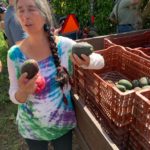 The farm has three main objectives –
The farm has three main objectives –
– Biodiversity
– Integration with local community
– Self sufficiency
Marcella has plans for diversification across the farm with an intention to implement a processing and packing plant on site – at present, all fruit is processed off farm. She is also exploring opportunities for renewable energy across the property.
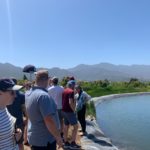
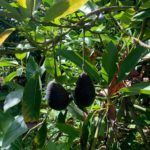 The avocado crop is in bloom from mid-October for around 6 weeks and for every 1,000 flowers, one fruit will be produced. Harvesting of the crop is carried out between September and March meaning two crops are growing at any one time. This can lead to management issues with the ripe fruit limiting the formation of new fruits. The trees are pruned in autumn and spring to encourage fresh growth.
The avocado crop is in bloom from mid-October for around 6 weeks and for every 1,000 flowers, one fruit will be produced. Harvesting of the crop is carried out between September and March meaning two crops are growing at any one time. This can lead to management issues with the ripe fruit limiting the formation of new fruits. The trees are pruned in autumn and spring to encourage fresh growth.
Irrigation is critical from growing the crop with 1ha requiring an average of 8,000 litres of water per annum. The average yield of this organic crop is around 12 tonnes per hectare however a more conventional farm may achieve yields of up to 15 tonnes per hectare.
Organic farming allows the soils here to retain a higher level of moisture and leaf cover on the ground is a crucial part of this. The roots of an avocado tree are very superficial, and their depth does not support their demand for water. Irrigation is provided by a jet system at ground level and when required, organic fertilisers are also distributed via this system.
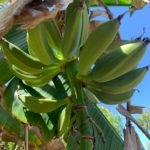 The farm employs 22 people full time with all crops harvested by hand with ladders and poles. The crop is sold through a variety of supermarkets, town markets and individual consumers.
The farm employs 22 people full time with all crops harvested by hand with ladders and poles. The crop is sold through a variety of supermarkets, town markets and individual consumers.
The average shelf life of fruit from harvest to consumer is around 1 month. This allows a sufficient window for shipping to international markets, but any delay can be of significant cost to the producers. The fruit is stored at a temperature of 5c for transportation.
Current market average for an organic avocado sale is around 2,790 pesos per kilo which equates to around £2.79 per kilo. Organic produce benefits from a 20-30% market premium over conventional produce. All fruit produced at Crisol supplies a domestic market only. The optimum fruit for export is over 170g however the domestic market in Chile demands a smaller fruit of around 120g. Over 70% of the Avocados produced in Chile are exported internationally.
In advance of harvest, fruit is sampled by a lab to establish oil content. A fruit’s oil content should be over 9% at time of harvest with the later season fruits being well in excess of this level. Disease is also monitored with a contractor checking the crop on a monthly basis. When required, natural methods of disease control are adopted including the use of Lady Birds.
Fertiliser is produced naturally with animal manure, grass cuttings and food waste being composted and then mixed with water to create a tea. The farm also grows small number of bananas for diversification and water retention benefits. Being high in potassium is good for fertilisation of the soil and whilst these fruits are not sold commercially, they are edible when cooked.
A frost prevention system is in place which is powered by gas via a small turbine. It is hard to imagine a frost as we stand here in almost 30c but when required, this system can bring the air temperature up by 2c over an area of 5ha which is crucial for retention of the fruit.
Whilst we have enjoyed the opportunity to consume locally produced avocados here on a daily basis, we can see clearly the damage that mass production for the global market is starting to have on the local environment.
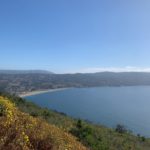
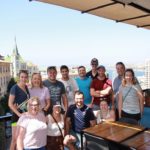 Here, we enjoyed a beautiful seafood lunch with views over the town below before taking a funicular railway to the lower streets to witness the scale of the Port here. The number of containers waiting to be loaded and shipped was impressive to see following two weeks of discussing shipping and exportation. There was then time for a short walk around the town including some small-town markets where final souvenirs were purchased.
Here, we enjoyed a beautiful seafood lunch with views over the town below before taking a funicular railway to the lower streets to witness the scale of the Port here. The number of containers waiting to be loaded and shipped was impressive to see following two weeks of discussing shipping and exportation. There was then time for a short walk around the town including some small-town markets where final souvenirs were purchased.
With a short de-tour for some beautiful coastal views, we were on our way back to Santiago for a final supper before our long flight home on Saturday afternoon.
Rosanna Fraser

